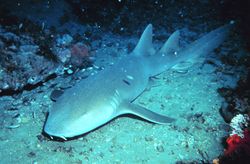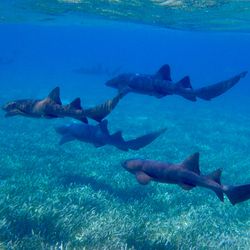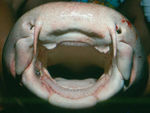Nurse shark
| Nurse shark |
|---|

|
| Scientific Classification |
|
| Binomial Name |
|
Ginglymostoma cirratum |
| A herd of nurse sharks swimming together |
The Nurse shark is a fairly large species of shark known by the scientific name Ginglymostoma cirratum. This 10-12-foot shark usually spends its days slowly roaming and foraging the sea floor for small creatures to eat, such as crabs, lobsters, shrimp, krill, squids, octopus, and even sometimes the rough coral of a coral reef[2]; these few examples of what the nurse shark eats are not all that the nurse shark eats, however, humans are not part of their regular eating diet. The nurse shark etas these small creatures by sucking it into its mouth by using the vacuum caused by the fast opening of its mouth, drawing the creature into the nurse sharks mouth by the compelling vacuum. The nurse shark, however, is a slow creature unlike many other sharks and spends the rest of the day even sleeping. But at night is when the nurse shark is usually more active, you could call them nocturnal meaning that they are only active at night, but they are also very active during the day as well. Some even call them the couch potatoes of the sea[3] because of their slow speed during the day, but during the night they are as active as ever.
Body Design
The Nurse shark does not differ from most sharks in the way the body design as far as fins and shape, but it still has some unique features that make it different among the other types of sharks out in the waters. The Nurse Shark itself has a very tough hide that is very tick which provides the shark with protection and outer skin armor. This outer layer of skin is the epidermis of the shark and can be a variant of light brown spots to dark brown spots on the top of the shark are, on the lower side it fades more into a creamy white color. Nurse sharks when they “hatch”, are usually about 1ft. and they can later grow up to 7ft. , depending if they are male or female because males grow up to 7 feet and females can grow up to 7 feet and 6 inches. The nurse sharks fins are all the same as far as gender-wise and their fins look a lot like any other shark you might have seen. Nurse sharks have two rounded dorsal fins, a pectoral and pelvic fin and a long caudal fin in the back as well as an anal fin on the bottom of their body.
The nurse shark also has an abnormally large head as far as sharks go and on this head, they have two small yellowish eyes and nasal barbels which are used as taste buds in water and for searching for food in murky waters on the sea floors. their teeth are like many other sharks, with multiple rows of serrated teeth that fall out regularly and then after are replaced with more teeth from the rows of teeth behind the lost tooth. There are a few differences between male and females that help tell them apart, they include males with generally more spots on its body and males are generally smaller when full grown than the females, males also have what is called a clasper on the bottom of their body. Females, on the other hand, have fewer spots and a more stream-like design, they have a precaudal pit and a caudal keel which one is used in shark reproduction and the other is used for stability in the water. Nurse sharks use their slender body to creep along the seafloor at slow speeds capturing mollusks and small sea animals such as fish, shells, and other small crustaceans. By using their nasal barbels they can search the seafloor for these small creatures, the barbels are also used for tasting the food when it goes into the nurse sharks open mouth.[4]
Life Cycle
Nurse sharks are ovoviviparous, which means that their eggs are produced inside of the female nurse shark, these eggs are then exited from the nurse shark and can number from 20-30 pups in one full litter. The eggs are a jell ball like substance with a yellowy-clear surface; the sac itself is absorbed slowly during the development of the young pup inside of the yolk sac. Gestation inside of the mother usually takes about six months until the young pups are exited from the mother, each pup can measure from 10.6–11.8 in. (27-30 cm.) in length. The male nurse sharks have a very strange way of matting compared to other creatures of the ocean, the male shark approaches a resting on the seafloor, the male bites the female’s pectoral fin and attempts to flip her over. Keep in mind this is very hard for the male because the females can grow much larger than their male counterparts by a couple of inches, this process of flipping usually has the downside of the female getting bites and bruises all over her while the male is trying to subdue her. Once the male shark has successfully flipped the female they begin to mate. [5]
Ecology
Much like other sharks the nurse shark enjoys warm waters and regularly stays in areas with warm waters. The nurse shark is native to many areas along the US shores, Mexico and as well as some areas over along the west coasts of Africa; to be specific Anguilla; Antigua and Barbuda; Aruba; Bahamas; Barbados; Belize; Bermuda; Bonaire, Sint Eustatius and Saba (Saba, Sint Eustatius); Brazil; Cameroon; Cape Verde; Costa Rica; Cuba; Dominica; Ecuador; Equatorial Guinea; France; Haiti; Honduras; Jamaica; Martinique; Mexico; Montserrat; Panama; Peru; Puerto Rico; Us ; etc[6].... This seems strange to many people because the nurse shark is very docile during the day, roaming the sea floors looking for small crustaceans to have for a mid-morning snack. But at night the nurse shark is as active as any other shark, roaming the sea floor at higher speeds than during the day, traveling far to get to mating grounds before late spring.
Nature
You may think of sharks as very vicious creatures who devour thousands of people, but that is not true. the actual death rate of all sharks per year is only around 80 people[7], and that is because sharks get confused that the people they are attacking are actually other large prey. Nurse sharks, however, are not like any other shark in that they have never killed a human, mainly because of their size and body design, but also because they are very docile creatures that is why they are so commonly visited by tourist traveling to exotic places to get a taste of the underwater wildlife. The reason why so many tourists enjoy looking at these sharks is that they don't mind if you are around them, they let you get close which is a rare thing to find when swimming with sharks. When you are near a nurse shark you should never touch it without permission however because it is known to bite if it is aggravated, but even if you did get bitten it would not be fatal, but it would hurt allot. This docile nature of the nurse shark allows them to be an ideal candidate for aquariums compared to the normal shark, although the nurse shark may not eat humans it does like to eat small crustaceans along the sea floor which combined with its slowness and great ability to turn it does fairly well in small combined spaces such as an aquarium compared to the many open ocean fast-traveling sharks who usually die after a few months or even weeks in an aquarium because they are used to long distance travel and don’t usually have to turn much so they bump into the walls of the aquarium causing their confinement to kill them in the end, which makes the alternative choice of the nurse shark a great choice.[8]
Video
Describes the basic habits of the nurse shark.
References
- ↑ Edmonds, Molly. How Nurse Sharks Work How Stuff Works. Web.Visited April 29, 2018.
- ↑ Rogers, Michael. Nurse Sharks: Ten Facts About The Couch Potatoes Of The Sea Shark Sider. Web. September 21, 2016.
- ↑ Ginglymostoma cirratum Florida Museum. Web. April 13, 2018. Author Unknown
- ↑ Ginglymostoma cirratum Florida Museum. visited on April 27, 2018. Author Unknown
- ↑ Ginglymostoma cirratum IUCN red list. Web. visited April 29, 2018. Author Unknown
- ↑ French, Lindsay. Yearly Worldwide Shark Attack Summary Florida Museum. Web. Accessed April 29, 2018.
- ↑ Rogers, Michael. Nurse Sharks: Ten Facts About The Couch Potatoes Of The Sea Shark Sider. Web. September 21, 2016.



